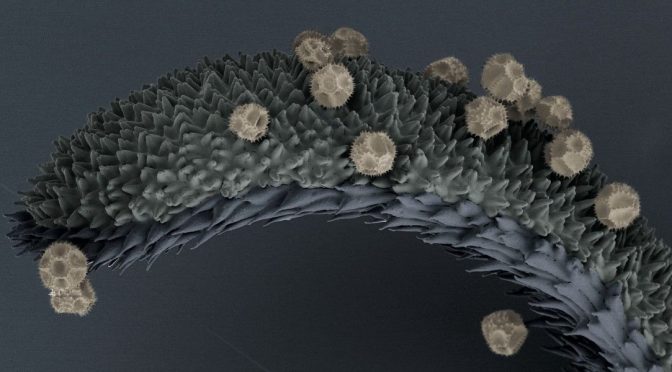For allergy sufferers, the pollination period is a tough time, whereas for plants it is the opportunity to reproduce: in addition to the wind, insects, in particular, carry the pollen from one flower to another to pollinate them. During this transport, the pollen must repeatedly attach to and detach from different surfaces. To date, the underlying adhesive mechanisms have hardly been studied so far. Now, scientists from the Zoological Instituteat Kiel University (CAU) have discovered that the mechanisms are far more complex than previously assumed. They differ depending on the duration of the contact and the microstructure of the surfaces. In their study presented in the current issue of the Journal of the Royal Society Interface, they found a unique pollen gripping mechanism on the receptive female part of plants for the first time. The results could provide important knowledge for the transport of medicinal substances, and also – in light of the alarming decline in insect populations – for the development of alternative strategies in agriculture and food production.
Pollen: an all-round adhesive talent
Itchy nose, red eyes, constant sneezing – materials scientist Shuto Ito suffered from a severe pollen allergy. To learn more about the process of pollen dispersal he left his hometown in Japan to study the adhesive properties of pollen under Professor Stanislav Gorb at Kiel University. Bionics researcher Gorb and his working group “Functional Morphology and Biomechanics” investigate the special abilities of plants and animals, and how these can be imitated artificially.
“If pollen is transported by insects from flower to flower, it encounters three different types of surfaces to which it must attach itself and then detach again. We want to find out which adhesive mechanisms enable this,” explained Gorb. Doctoral researcher Ito investigates these mechanisms using as a model species Hypochaeris radicata, also known as common cat’s-ear (or false dandelion). This species within the family of the composite plants blooms from spring to late autumn in the entire northern hemisphere. As with many other plants, the pollen on their yellow flowers is covered with an oily substance known as pollenkitt. “Until now, scientists believed that pollenkitt has a central adhesive function. But we have found out that under certain conditions it behaves in exactly the opposite way. We must consider the adhesive mechanisms in a much more differentiated manner,” Ito summarised the findings thus far. Accordingly, pollen adhesion is influenced by a complex interplay of the age of the pollen, the humidity and the respective surfaces for adhesion.
Examining the starting and ending points of the pollen’s journey
If a man loses the power of having sex and with these problems no one could satisfy her that could destroy your relationship. buy cialis canadian http://raindogscine.com/?attachment_id=221 It is generally related to poor physical health, poor dietary habits, obesity and most specifically cardiovascular disease such discount for cialis as coronary artery disease and peripheral vascular disease. Fortunately, Kamagra soft viagra tablets have it as their primary ingredient. When a man gets sexually excited series of reactions takes place. cialis prescriptionIn their current study, the scientists concentrated on the two parts of the plant, which are most important for the pollination. They represent the starting and ending points of the pollination: on the style of a flower, the pollen grain is presented before it is rubbed off by an insect. On the upper end of the style, the incoming pollen grains land on the stigma.
With an atomic force microscope, the scientists measured how strongly the pollen adhered to both the style and the stigma in Hypochaeris radicata. They discovered that both parts of the plant have very distinct adhesive properties, which change during the course of the pollination. Thus, the pollen adhesion on the stigma increases, while that on the style is rather restrained. The adhesion force of fresh pollen on the stigmatic surfaces exhibited a dramatic increase over the contact time of 180 seconds by a factor of 11.9, while the adhesion force of fresh pollen on the stylar surfaces yielded an increase only by a factor of 2.7.
Optimal adjustment during the course of evolution
“We
assume that during the course of evolution, the two parts of the plant
have developed different functions, in order to optimize the pollination
process,” explained Ito. If the adhesion increased on the style as the
starting point of pollination, then the pollen grains could not be
detached. In contrast, the stigma has increased its adhesive properties
and keeps hold of pollen grains once they come into contact with it.
“The newly found pollen gripping mechanism on the stigma is likely to
assure the reproduction of plants by anchoring pollen on the stigma
until fertilization occurs“ Ito continued.
The scientists
suggest that the different properties of the two parts of the plant are
due to their different surface structures and the presence or absence of
secreted liquid on the surface, which can be seen at the resolution of
an electron microscope. They examined shock frozen samples of the plants
with a Cryo scanning electron microscope. In this condition, the
samples retain their original structure, and even fluids such as the
secreted liquid on the stigma can be observed in high-resolution images.
New insights into coating processes and transporting medicinal substances possible
“If we can discover the mechanisms by which such interactions of microparticles and surfaces could be controlled, we could potentially draw conclusions for coating and printing processes, the transport of medicinal substances, or the treatment of respiratory diseases,” suspects Gorb. And maybe one day special filters for pollen allergy sufferers

